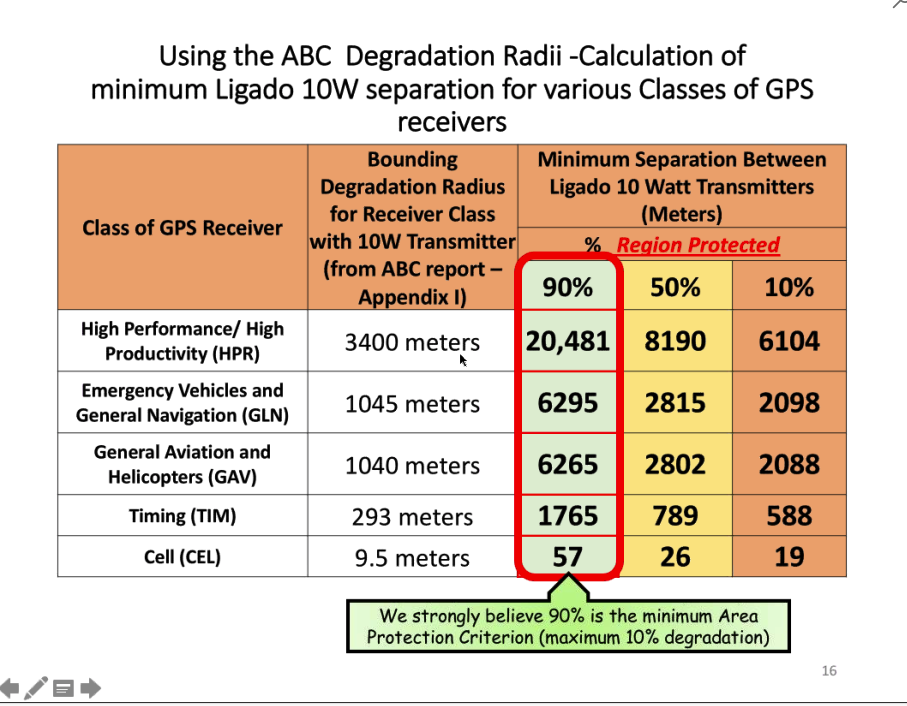
The Federal Communications Commission (FCC) is officially asking for feedback on a proposal by Ligado Networks to repurpose frequencies near the GPS band for a terrestrial broadband network. The long-delayed public notice and comment period is a step in the approval process, although there is no assurance that Ligado’s plan for a new wireless service — which may still cause interference to GPS receivers — will get the go-ahead.
The Federal Communications Commission (FCC) is officially asking for feedback on a proposal by Ligado Networks to repurpose frequencies near the GPS band for a terrestrial broadband network. The long-delayed public notice and comment period is a step in the approval process, although there is no assurance that Ligado’s plan for a new wireless service — which may still cause interference to GPS receivers — will get the go-ahead.
The current proposal is similar to ones made when the firm was still called LightSquared but has a few additional elements. Of the two 10-megahertz bands closest to the GPS frequencies Ligado would formally abandon the 1545–1555 MHz downlink band, leaving it the 1526–1536 MHz band for downlinks. It would also reduce the effective isotropically radiated power (EIRP) limit for this band from 42 dBW to 32 dBW.
Ligado has also requested that it be allowed to share the 1675.0–1680.0 MHz band now used by the National Oceanic and Atmospheric Administration. It already has the frequencies from 1670.0 to 1675.0 MHz. Sharing would give it a total of 10-megahertz to make up for the frequencies it is abandoning.
Uplinks would be in the bands 1627.5–1637.5 MHz and 1646.5–1656.5 MHz. A host of limits on power and out-of-band-emissions apply to the various frequency ranges. A summary of the overall proposal can be found in the appendix on page 10 of the Ligado submission to the FCC.
The deadline for filing comments and denial petitions is May 23. Oppositions are due June 6 and replies June 16. The International Bureau dockets with the relevant filings and comments are IB Docket No. 11-109 and IB Docket No. 12-340.
“These public notices are important steps in the process, and we are pleased the FCC has formally begun the public discussion," said Ashley Durmer, Ligado’s senior vice president of government relations and corporate communications. "Our new proposal is the result of much study and collaboration by our new management team to protect GPS, and we are motivated to continue supporting innovative solutions enabling the delivery of this mid-band spectrum for next-generation networks."
The proposal incorporates elements from agreements reached by Ligado with Deere & Company, Garmin International, Inc., and Trimble Navigation — three GPS receiver manufacturers sued by Ligado’s predecessor LightSquared and with whom it recently settled. Ligado has suggested that, because the three companies provide a wide range of receivers and the manufacturers have come to an understanding with Ligado on power limits and other issues enabling a way forward, the agreed-to limits outlined in the proposal to the FCC should protect the GPS community as a whole.
Test Methodology Differences
Ligado also asserts that its own tests, conducted by Roberson and Associates, show no interference with general navigation receivers, cell phones, and other GPS-enabled devices.
Not all of the results from those tests are publicly available, however, and GPS experts have repeatedly called Ligado’s test methodology into question. Specifically, the widely accepted yardstick for measuring interference is the change in the signal-to-noise ratio or C/N0.
The Adjacent Band Compatibility Assessment, now underway under the sponsorship of the Department of Transportation, is using a change of one decibel to develop a set of masks, that is, limits by frequency on the amount of interference that can be safely tolerated by GPS devices. LightSquared consistently took issue with the signal-to-noise metric saying that using the actual change in the position accuracy determined by a receiver is more appropriate.
"Our position has not changed, and in our view, the proper measure of interference is whether there is any impact to the critical information a GPS device provides in the presence of other signals," said Durmer. "There is no evidence to show a correlation between a 1 dB change in C/N0 and the performance and function of a GPS device. We remain committed to data-driven decision making and ensuring that our signal does not interfere with GPS, and in early May, we will file the results from the Roberson and Associates testing."
Ligado does acknowledge, however, that interference issues remain unresolved for at least one important set of devices — certified aviation receivers.
"To protect certified aviation GPS devices," the FCC wrote in its notice, "Ligado proposes that its license be conditioned on power limitation requirements for operation in the 1526–1536 MHz band as necessary to achieve compatibility with current and future Minimum Operational Performance Standards that are incorporated into an active Technical Standard Order from the Federal Aviation Administration."
The FAA and the standard setting body RTCA would develop that Technical Standard Order or TSO, Ligado suggested in a December 31, 2015 filing with the FCC. RTCA operates by consensus and regularly undertakes such projects for FAA.
Also unresolved are concerns among federal GPS users — in particular those of the Department of Defense. Gen. John Hyten, the commander of the Air Force Space Command that manages the GPS program, told a March 15 congressional hearing he had yet to see data indicating Ligado’s new plan would not hamper GPS usage.
"The position of Air Force Space Command is the same," as it was under his predecessor Gen. (William) Shelton, Hyten told the House Subcommittee on Strategic Forces. "I don’t think that we should infringe on the GPS spectrum. That’s a critical capability not just for the military security of the nation but for the entire economic well being of this nation. We can’t allow that to happen."
Nonetheless there is pressure for progress on Ligado’s plan. Rep. Gerry Connolly, D-Virginia, who sits on the House Committee on Oversight and Government Reform that helps oversee the FCC, wrote in February to FCC Chairman Tom Wheeler, asking that the commission "move forward with a public notice and a three-month comment" on the Ligado proposal. Ligado is located in the Connolly’s district.
"I am pleased to inform you that after extensive coordination with our federal partners, we are in the final stages of preparing a public notice to see comment on the Ligado proposals," Wheeler wrote to Connolly on April 7. "I can assure you that the commission will engage in an open and transparent process to consider Ligado’s proposals. Our analysis will be conducted in the context of our ongoing efforts to make additional spectrum available for mobile broadband services and will be comprehensive and informed by an objective engineering review of the band and input from a broad range of stakeholders."





